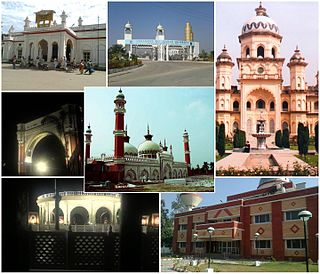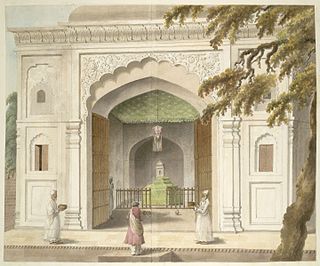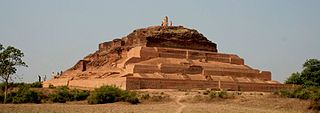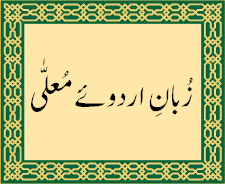
Rampur is a town and the municipality headquarter of Rampur District in the Indian state of Uttar Pradesh. It was formerly known for its various industries, like sugar refining and cotton milling. Its library has more than 12,000 rare manuscripts and a fine collection of Mughal miniature paintings. It is located 322 kilometres north-west of the state capital Lucknow & approx 180 kilometres from the national capital New Delhi.

Rohilkhand is a region in the northwestern part of Uttar Pradesh, India, that is centered on the Bareilly and Moradabad divisions. It is part of the upper Ganges Plain, and is named after the Rohilla. The region was called Madhyadesh and Panchala in the Sanskrit epics Mahabharata and Ramayana. During the colonial era in India, the region was governed by the Royal House of Rampur.

Bareilly is a city in Bareilly district in the Indian state of Uttar Pradesh. It is among the largest metropolises in Western Uttar Pradesh and is the centre of the Bareilly division as well as the historical region of Rohilkhand. The city lies in the Indo-Gangetic Plains, about 252 kilometres (157 mi) northwest of the state capital, Lucknow, and 265 kilometres (165 mi) east of the national capital, New Delhi. With a population of 903,668 in 2011, it is the eighth most populous city in the state, 17th in northern India and 54th in India. It is located on the bank of Ramganga River and is the site of the Ramganga Barrage built for canal irrigation.

Nawab Muhammad Amir Khan (1769–1834) was a military general in the service of Yashwantrao Holkar of the Maratha Empire and later became the first ruler of the princely state of Tonk. Amir Khan was a Hindustani Pathan and a North Indian Muslim. Born and bred in Sambhal, Amir Khan was the son of a Zamindar in Uttar Pradesh, Hayat Khan, while his grandfather Taleh Khan was a Pashtun from the Salarzai tribe of District Buner in modern-day Pakistan who had migrated to and acquired land in Rohilkhand.

Rohillas are a community of Pashtun heritage, historically found in Rohilkhand, a region in the state of Uttar Pradesh, India. It forms the largest Pashtun diaspora community in India, and has given its name to the Rohilkhand region. The Rohilla military chiefs settled in this region of northern India in the 1720s, the first of whom was Ali Mohammed Khan.

The Bareilly district belongs to the state Uttar Pradesh in northern India. Its capital is Bareilly city and it is divided in six administrative division or tehsils: Aonla, Baheri, Bareilly city, Faridpur, Mirganj, and Nawabganj. The Bareilly district is a part of the Bareilly Division and occupies an area of 4120 km2 with a population of 4,448,359 people according to the census of 2011.

Bijnor district is one of the 75 districts in the state of Uttar Pradesh in India. Bijnor city is the district headquarters. The government of Nagar Palika Parishad Bijnor Uttar Pradesh seeks its inclusion in National Capital Region (NCR) due to its close proximity to NCT of Delhi.

General Bakht Khan (1797–1859) was the commander-in-chief of the Indian rebel forces in the city of Delhi during the Indian Rebellion of 1857 against the East India Company.

Shahjahanpur is a district of Uttar Pradesh India. It is a part of Bareilly division. It was established in 1813 by the British Government. Previously it was a part of district Bareilly. Geographically the main town is Shahjahanpur which is its headquarters. Its 5 Tehsils are: Powayan, Kalan, Tilhar, Jalalabad and Sadar.

Moradabad district is one of the districts of Uttar Pradesh, India. The city of Moradabad is the district headquarters. Moradabad district is part of Moradabad division. It used to be the second most populous district of Uttar Pradesh out of 75 after Prayagraj till a new district Sambhal was carved out of it in 2011.

Hafiz Rahmat Khan was the Regent of Rohilkhand in North India, from 1749 to 1774. He was a Pashtun by background, ruling over Rohillas. Hafiz Rahmat Khan had served honorably throughout the reign of three Mughal Emperors: Ahmad Shah Bahadur, Alamgir II and Shah Alam II. He was also a mentor of Prince Mirza Jawan Bakht.

Khan Bahadur Khan Rohilla was the grandson of Hafiz Rahmat Khan, who was the Nawab of Rohilkhand in Uttar Pradesh. He formed his own government in Bareilly in the 1857 Indian revolt against the Company rule. During the Indian Rebellion of 1857, Bareilly, too, was captured by the British. Rohilla escaped to Nepal where the Nepal army captured him and turned him over to the British. Khan Bahadur Khan Rohilla was tried, sentenced to death, and hanged in the Kotwali on 24 February 1860.
The Punjabi Saudagaran-e-Delhi, sometimes referred to as the Qaum-e-Punjabian, Delhi Walay, Dehlawi, or simply Shamsi Biradari are a community of Muslim Khatris that historically came from Sargodha in Punjab and then lived mainly in Old Delhi, India. They also settled in a number of other cities such as towns in western Uttar Pradesh, such as Agra, Aligarh, Meerut, Moradabad, Bareilly, Rampur, Kanpur; including areas within western Uttar Pradesh that now falls in the state of Uttarakhand; namely Roorkee, Nainital and Haldwani. After the partition of India, and subsequent independence of Pakistan in 1947, many members of the community migrated to Pakistan, particularly Karachi and Lahore, while few chose to migrate to Mecca and Medina.

GujaratiPathans are a group of Pashtuns, who are settled in the region of Gujarat in western India. They now form a distinct community of Gujarati and Urdu/Hindi speaking Muslims. They mainly speak Urdu with many Pashto loanwords, but most of them have been Indianized so some may have Gujarati as their first language as well, few elders in the community still speak Pashto. Common tribes include Turk pathan, Babi or Babai, Niazi, Khan, Bangash, Durrani, and Yousafzai.

The Pathans are an Urdu-speaking community of Pashtun descent in the Uttar Pradesh state in India who form one of the largest Muslim communities in the state with a population of 5-6 million and 2.9% of the total population of Uttar Pradesh They are also known as Khans which is a commonly used surname amongst them; although not all those who use the surname are Pathans, for example the Khanzada community of eastern Uttar Pradesh are also commonly known as Khan. The phrase Pathan Khanzada is used to describe Muslim warrior groups, found mainly in Gorakhpur, who have been absorbed into the Pathan community. There are communities of partial Pashtun ancestry in the Rohilkhand region and in parts of the Doab and Awadh regions, such as the agrarian Rohilla community.

Islam in Uttar Pradesh is the second largest religion in the state with 38,483,967 adherents in 2011, forming 19.26% of the total population. Muslims of Uttar Pradesh have also been referred to as Hindustani Musalman. They do not form a unified ethnic community, but are differentiated by sectarian and Baradari divisions, as well as by language and geography. Nevertheless, the community shares some unifying cultural factors. Uttar Pradesh has more Muslims than any Muslim-majority country in the world except Indonesia, Pakistan, Bangladesh, Nigeria, Egypt, Iran, Turkey, Iraq and Afghanistan.

Western Uttar Pradesh is a region in India that comprises the western districts of Uttar Pradesh state, including the areas of Rohilkhand and those where Hindi, Urdu and Braj are spoken; it is in the region of Western Uttar Pradesh that Hindi-Urdu originated. The region has some demographic, economic and cultural patterns that are distinct from other parts of Uttar Pradesh, and more closely resemble those of Haryana and Rajasthan states. The largest city of the region is Ghaziabad, while the second-largest city, Agra, is a major tourist destination.

According to the epic Mahābhārata, Bareilly region (Panchala) is said to be the birthplace of Draupadi, who was also referred to as 'Panchali' by Kṛṣṇā. When Yudhishthira becomes the king of Hastinapura at the end of the Mahābhārata, Draupadi becomes his queen. The folklore says that Gautama Buddha had once visited the ancient fortress city of Ahicchattra in Bareilly. The Jain Tirthankara Parshva is said to have attained Kaivalya at Ahichhatra.

The Pathans of Madhya Pradesh are an Urdu-speaking Pashtun community settled in the present-day Indian state of Madhya Pradesh as well as a small minority of internal migrants and their descendants in neighbouring Chhattisgarh state, which was partitioned in 2000.

Native speakers of Urdu are spread across South Asia. The vast majority of them are Muslims of the Hindi–Urdu Belt of northern India, followed by the Deccani people of the Deccan plateau in south-central India, and most of the Muhajir people of Pakistan. The historical centres of Urdu speakers include Delhi and Lucknow. Another defunct variety of the language was historically spoken in Lahore for centuries before the name "Urdu" first began to appear. However, little is known about this defunct Lahori variety as it has not been spoken for centuries.



















